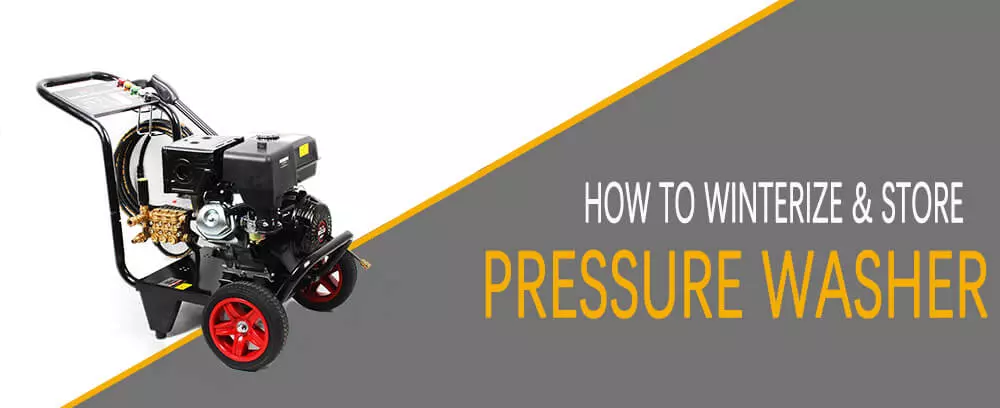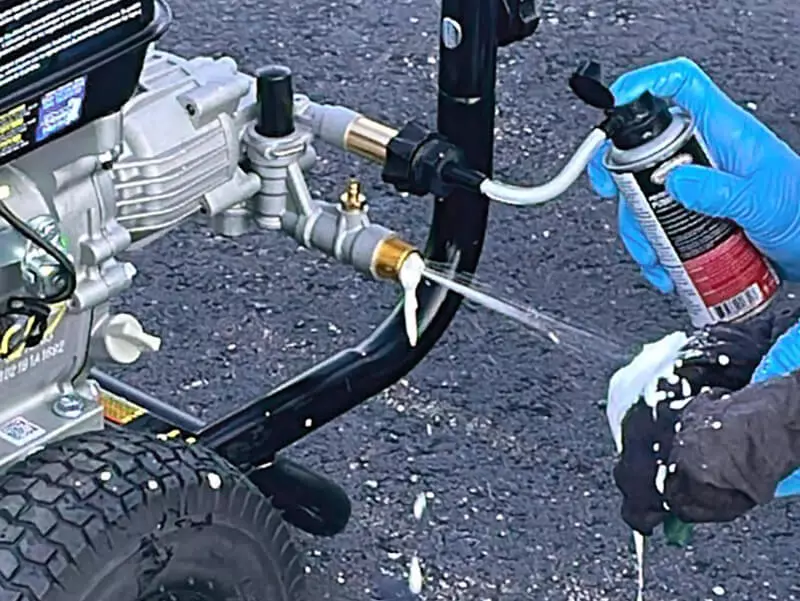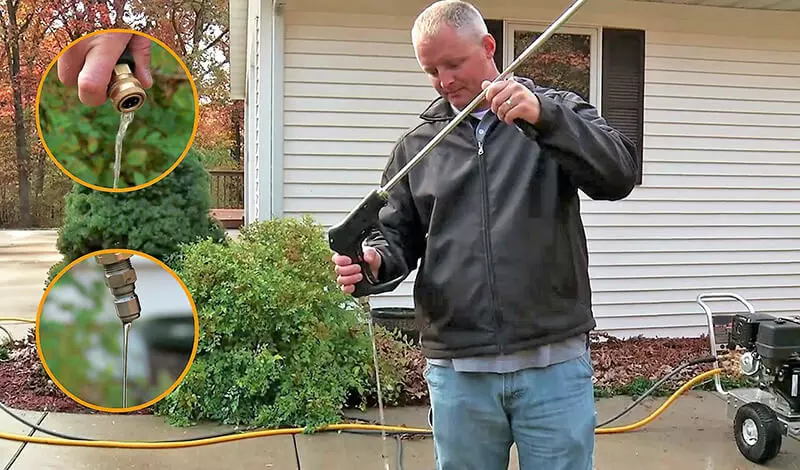how to winterize & store pressure washer
2024-06-21
Table of content

To extend the durability of your pressure washer, appropriate upkeep is crucial. This includes getting your pressure washer pump and motor ready for storage — particularly through a process of winterization — when they are going to be idle for a lengthy period.
Winter is marked by cold and harsh weather in most parts of the world. This causes many pressure washer operations to stop or slow down significantly. Before storing your pump equipment, it's essential to winterize your pressure washers to protect them from the elements and the effects of sitting idle for long periods.
Guidance to winterize & store your pressure washer
Should your machinery be put in storage exceeding a month, you might question how to suitably winterize the pressure washer to ensure it operates efficiently when you retrieve it for use in the spring. To aid this task, follow the detailed guidance provided below:
Prior to initiating winterization process of your pressure washer, it's crucial to conduct a comprehensive inspection.
Remove dirt and bebris: Start by thoroughly cleaning your pressure washer. Employ a moistened cloth to cleanse the exterior, removing any built-up dirt, grime, or scattered debris.
Inspect for any perceptible harm: Thoroughly check whole pressure washer for any visible indications of damage, look closely at all hoses and cables for signs of deterioration, and ascertain that all connections, fittings, and fasteners are firm and in place.
Drain the reservoir completely
Freeze/thaw cycles during the winter can cause any remaining liquid to expand and contract, potentially damaging the pump beyond repair. Ensure that the tank and plumbing are emptied of any cleaning solutions or liquids. To remove soap or water from the supply lines, turn on the pressure washer at minimum pressure for about one minute and pull the trigger.
Blow out plumbing and hose lines
Drain as much liquid as possible after disconnecting the high-pressure hoses, wand assembly, and spray gun. A small amount of water will remain in the plumbing system after draining. Any liquid that remains can be pumped out with an air compressor.
Flush the system with antifreeze
To avoid freezing of components, think about purging the system with a bit of antifreeze prior to the winter season. Make sure to drain any remaining fluid one more time. For example, antifreeze pump lubricant can prevent water from freezing in the pump. Adding it to the detergent reservoir or water inlet and running pressure washer for a few seconds will circulate the solution, ensuring starts all winter long.
Clean the filters
Remove the pump filters and clean any particles from the filter bowl or strainer. Make sure there is no residue on the metal mesh screen.
Clean the nozzles
Disassemble the nozzles and clean the orifice, removing any deposits to prevent corrosion.
Prevent rodent damage
Tiny rodents are capable of inflicting remarkable damage on wiring and various parts of pressure washers. To prevent rodent damage, use deterrents, traps, and other techniques, just as you might protect a car in a garage.
Disconnect the battery
If your pump is a battery-powered system, disconnect it to reduce the chance of completely draining the battery.
Take extra steps for gas-powered pumps
If your pump runs on a fuel system, drain all gasoline. An alternate method is to add a fuel stabilizer to the fuel tank and start the engine for a few minutes to facilitate the fuel's passage through the lines. Also, replace the spark plugs and unplug the wires.

Store in a dry place
It is best to store your pressure washer in a dry, clean location to prevent corrosion or weather-related damage. It is a wise idea to purchase a protective cover. A protective cover will help protect the machine from dust, moisture, and other potential damage, also use it to prevent dust from settling.
Follow the pressure washer manufacturer's recommendations
The best way to ensure you properly store and maintain your pressure washer equipment is to check with your manufacturer and review their recommendations. Generally, battery-powered or electric pressure washers require much less maintenance than gas-powered pumps. Electric pressure washers have simpler designs with fewer components, so there are fewer things that can malfunction.
Why should you winterize your pressure washers?
Regardless of keeping them in garages, they remain vulnerable to chilly weather conditions. The freezing and subsequent expansion of water can lead to notable harm to the pump, hoses, along with other elements of your machine. Pressure washers can endure damage due to severe temperatures and long spans of idle time. Undertaking the winterization of your pressure washer serves as a means to protect it against the cold while preserving the robustness of its internal seals. You'll also prevent problems with power generation—whether gas or electricity.
7 Quick steps to winterize your gas pressure washer
Winterizing your gas pressure washer ensures it stays in good condition during the colder months.
Here are seven quick steps to make it through winter:
Drain the water
Begin by shutting down the pressure washer and cutting off the water supply. Next, depress the trigger to relieve any built-up pressure and allow all the water to fully drain from the pump, hoses, and wand.

Add a pump protector
You need to add an antifreeze pump protector to the pump inlet to protect the internal seals. The freeze pump protector can prevent the formation of anti-formation and prevent its polymerization. Connect the pump protector to the inlet of the water pipe of the high-pressure washer, and press the switch of the pump protector until bubbles emerge from the end. This can be another part of the protection and seal damage during storage, as well as other internal components and pump head candy.
Flush the system
After the pump protector has been engaged, turn on the pressure washer for a short while to let the solution circulate throughout the system. This guarantees that every internal component is shielded and coated.
Drain or Stabilize the Fuel
Drain the fuel and drain the tank completely. If you do not want to drain fuel, using a fuel stabilizer in the tank is a good alternative, which can ensure that the gasoline will not deteriorate during storage and block the fuel line. After adding the fuel stabilizer, you need to run the gasoline pressure washer for at least 2 minutes to ensure that the fuel stabilizer is mixed with the gasoline in the entire fuel system, and then turn it off. For electric pressure washers, you don't need to do this step.
Oil Change
Performing an oil change before storing your pressure washer for the winter is an essential maintenance step. Fresh oil protects engine parts from corrosion and wear during months of inactivity.
Store indoors
Ideally, store your gas pressure washer in a dry, indoor location for the winter. If indoor storage is impossible, choose a well-insulated space such as a garage or shed to protect from freezing temperatures.
Do upkeep inspections
Before storing your pressure washer, examine it for wear or any damage.
Scrutinize the hoses, connectors, and seals for any possible leaks or fractures, and substitute any elements that are found to be substandard.
Consider performing thorough cleaning to remove any accumulations of dirt or filth that may pose problems down line.
3 Quick steps to winterize electric pressure washer
Another crucial step in preventing damage to an electric pressure washer during the winter is to winterize it. Here are three quick steps to make it through the winter:
Disconnect and drain
Please power down pressure washer and detach it from its electricity source. Detach any connected hoses and accessories, and let all the water completely empty out from the system. Remember to drain the water in the pumps, hoses, and spray guns as well.
Flush with antifreeze solution
In order to protect against frost damage and rusting, cleanse system with pressure washer-friendly antifreeze solution. Adhere to instructions provided by manufacturer for insertion of antifreeze to pump and circulation process throughout the system.
Store in a safe place
Find a dry, indoor storage location for your electric pressure washer during winter. Choose a well-insulated space such as a garage or shed if indoor storage is impossible. Make sure storage location is protected from freezing temperatures and moisture.
Winterize & store pressure washer tips
Here are some dos and don'ts to help you shield your pressure washer from damaging effects of cold weather.
Do's
Use a pressure washer pump saver.
Replace the fuel container if you see rust so as not to damage the fuel system.
Introduce antifreeze into the system, ideally in a ratio of 50:50 with water for optimal performance.
For chillier environments, consider a proportion of 60% antifreeze to 40% water to ensure better protection against freezing.
Inspect or replace the oil in the pressure washer pump.
Please do not cover the pressure washer immediately after use (wait for it to cool down to room temperature before coating).
FAQs
Can you leave a pressure washer on in freezing weather?
The risk of ice is most significant when your pump is not in use. Store the unit warmly to keep your pressure washer safe for regular overnight and weekend use. Remember, storing in an unheated shed does not protect your pressure washer from freezing.
Is it ok to leave pressure washer outside?
Store pressure washer in a place where it won't be exposed to freezing temperatures. If you allow it to remain where temperatures fall below freezing point, you risk the pump of your washer getting frozen, leading to potential cracks unless a pump saver is employed.
Conclusion
Pressure washers should be adequately winterized for longevity and optimal performance. You can ensure your pressure washer performs well during the colder months by following these essential steps — flushing the system, using a pump-saver solution, storing it safely, and maintaining a clean unit. These practices prevent freezing, corrosion, and damage, saving you from potential repairs and extending the life of your equipment. Remember, a little effort this winter can avoid significant problems and prepare your pressure washer for action come spring.
If you are thinking about upgrading or investing in a new machine, explore the latest in rugged and reliable pressure washers, such as BISON pressure washers. Visit our website to learn more about BISON pressure washers and find the perfect model for your needs. Prepare for winter with confidence with BISON.

